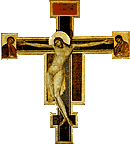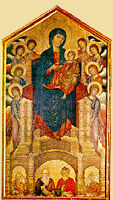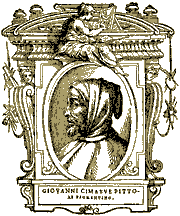Painter
Florence 1240/50 - 1302 ca.
The painting of Cimabue (who can only be found mentioned in documents between
1272 and 1302), concludes the era of the influence of Byzantine art. In
actual fact, although he always kept faith with the rules of the Byzantine
style, he took it to the greatest heights of expression while also carrying
out a new kind of research into form and colour: he thus paved the way for
Giotto and the new trends in Italian painting, mentioned by Dante when he
wrote about them in his "Purgatory".
He can be first found mentioned - because of his presence in Rome - in a document
of 1272. The Church was going through a period of renewal in this period and
supporting the various new monastic orders, among them that of the Franciscans.
Cimabue's second point of reference was therefore to become the Franciscan basilica
at Assisi, where he worked from 1278 c. onwards, alongside the Sienese painter,
Duccio di Buoninsegna, and Giotto from Florence (which tends to make it rather
difficult to properly judge how much artistic influence they were actually to
have on one another). He probably carried out the Crucifix in Arezzo (1265-68
c.), which still appears tense and rigid in style, before he went to Rome. The
famous Crucifix in Santa Croce (1272 c. - seriously
damaged during the flood of 1966 and since restored), with the structure of the
body moved by a new feeling of sensitivity, was instead painted before he went
to Assisi.

The Crucifix of S.Croce
Another of his masterpieces can be found in Florence (Uffizi):
the Majesty from Santa Trinita, where the angels and prophets are placed
around the Virgin according to a newly found feeling for forms and space.
The only work that can be documented with certainty is however the much altered
mosaic of St. John in the apse of the Duomo of Pisa:
the documents covering payments still exist (1301-2). The artist probably died
shortly afterwards.
At Assisi he is attributed with the huge cycle inspired by themes of the Apocalypse,
the Apostles and Mary, as well as the one of his most modern renderings of the
Crucifixion (now greatly damaged) and the four Evangelists in the vault. He was
probably helped here by several assistants.

Majesty
The Lower Basilica contains his Madonna with Angels and St. Francis. Another
work, his St. Francis in Santa Maria degli Angeli, portrays the saint for
the first time in a style that seems to have left the late Byzantine influences
far behind it.
Thought to have come from the school of Giunta Pisano (first half of the 13th
century), Cimabue was influenced by the new trends of the times, in the footsteps
of Coppo di Marcovaldo and later of Pietro Cavallini from Rome. The important
novelty he introduced passed through four kinds of research: the lively language
used in late Roman art (many examples of which could still be seen in Rome at
the time, though later destroyed, like the primitive basilica of St. Peter¹s),
the illuminated manuscripts of the early Middle Ages, the great Romanesque sculpture
and lastly the new classical style of Nicola Pisano.

